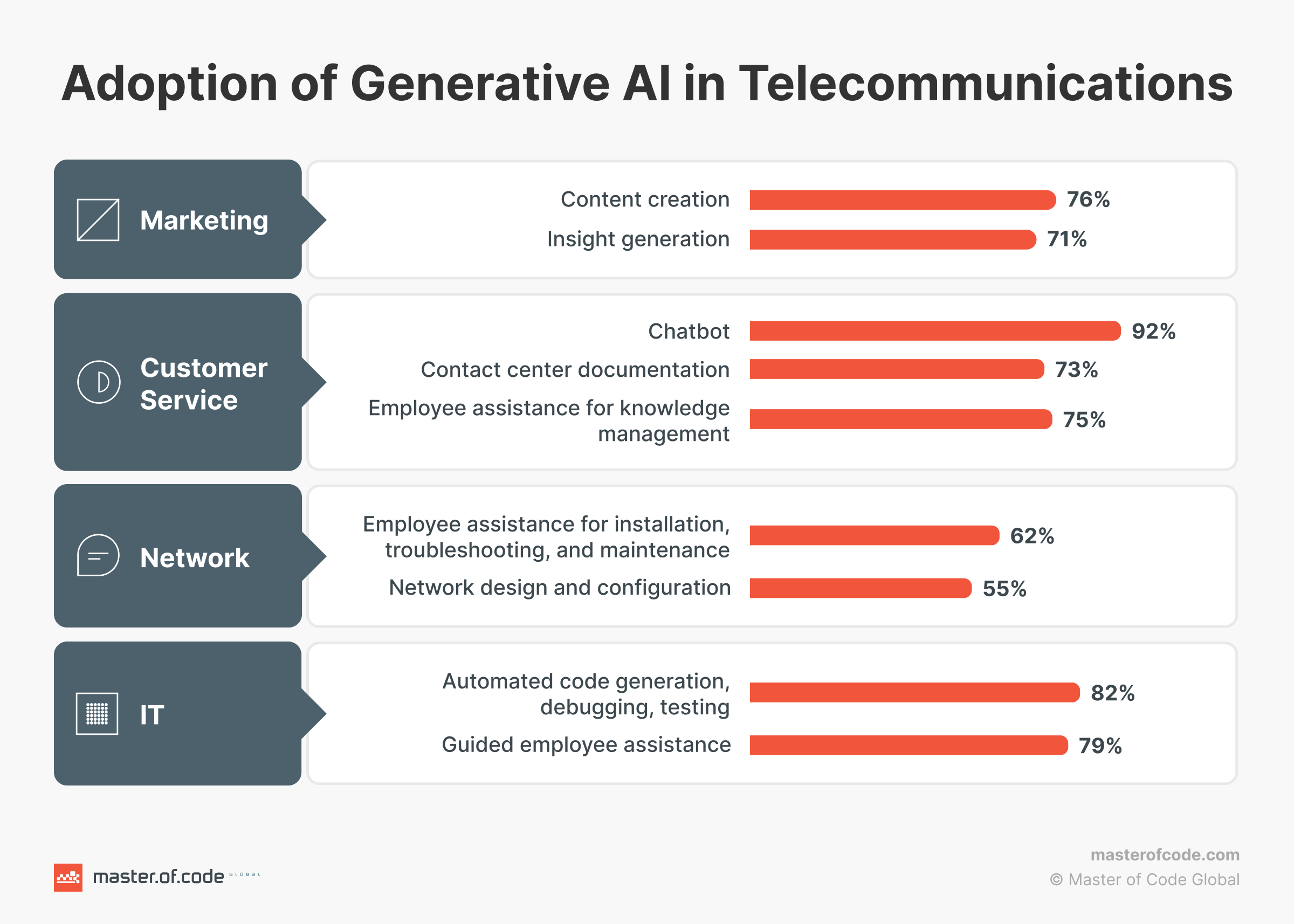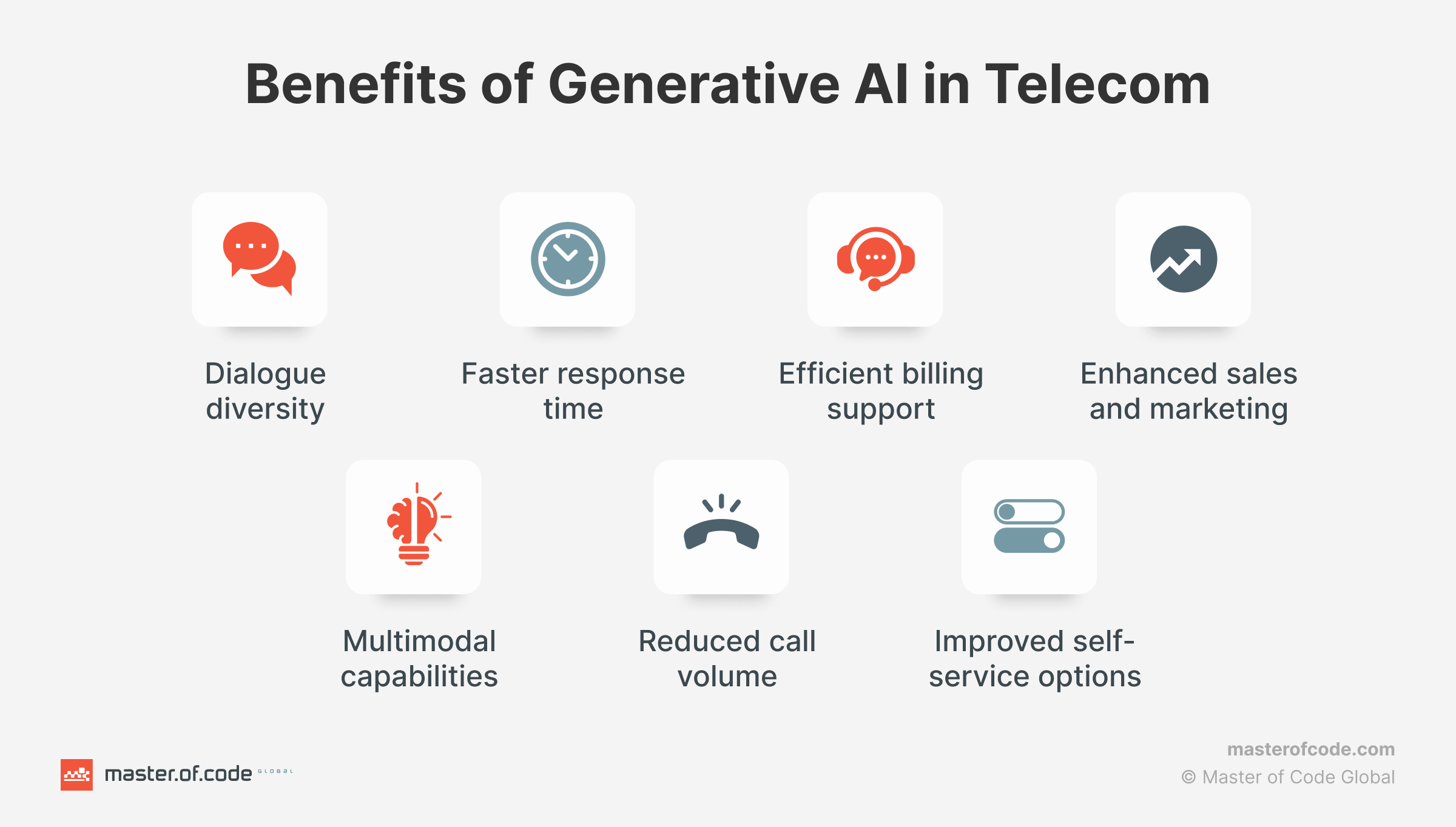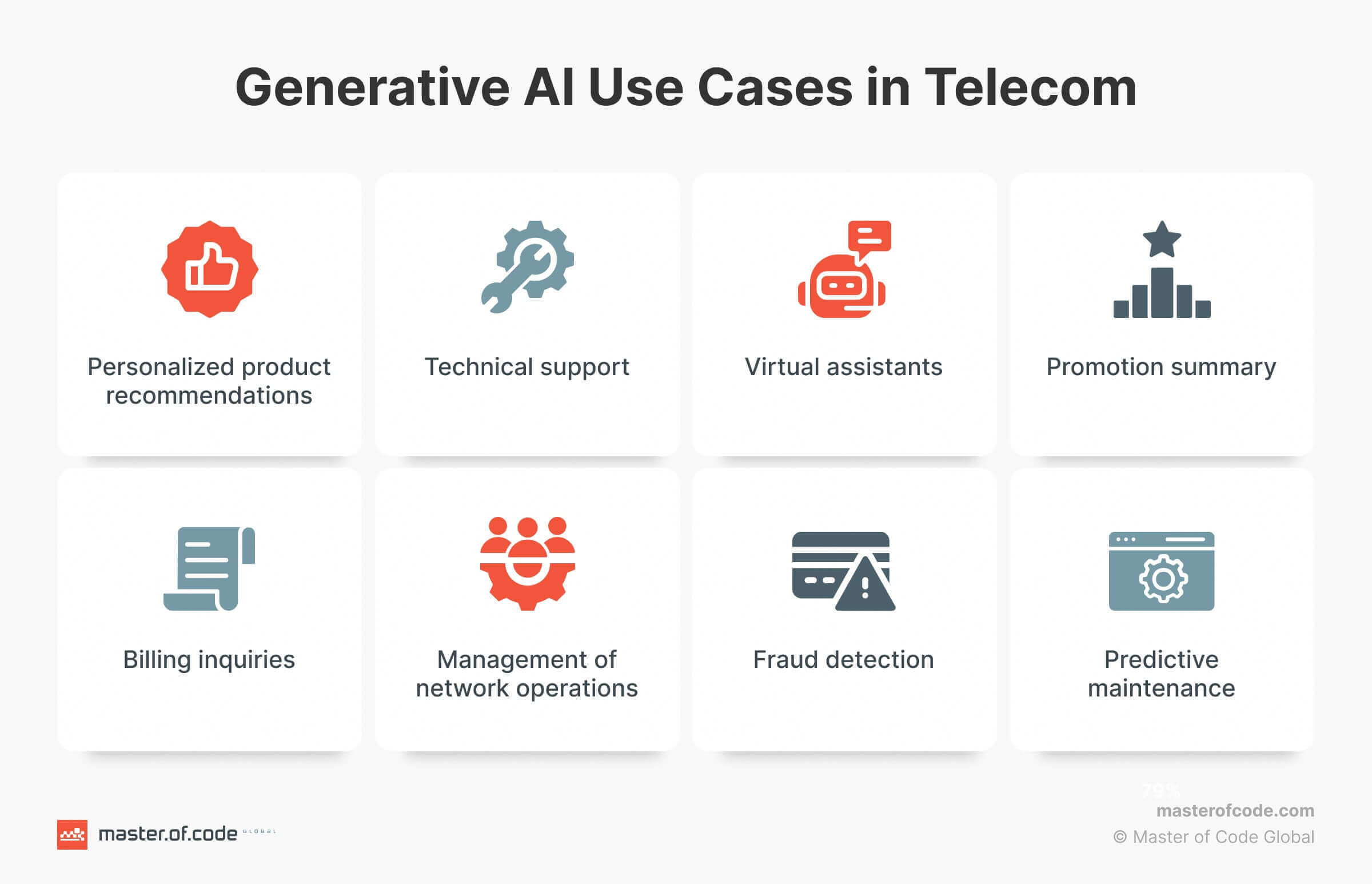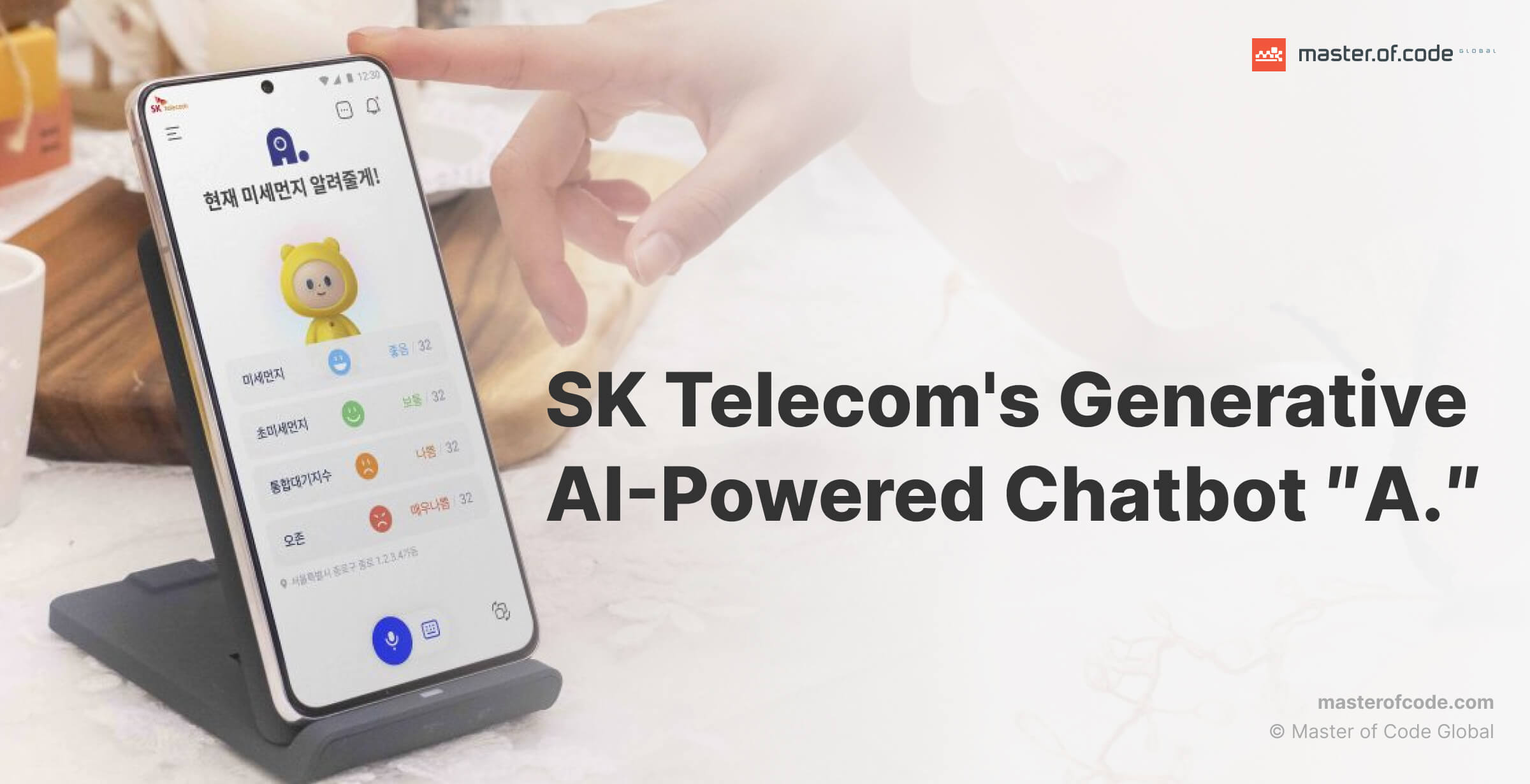Telecommunication companies are showing a growing interest in Generative AI tools. Generative AI integration can help communications service providers (CSPs) enhance customer service, increase sales and revenue, develop new products and offerings based on emerging trends, automate complex repetitive tasks, etc.
In fact, as per the recent report by Altman Solon and AWS on the state of Generative AI in Telecom market:
- 70% of CSPs recognize the distinct and significant value offered by Generative AI.
- 64% of CSPs view these use cases as net-new rather than mere replacements for existing applications.
- Current adoption rates for tested use cases stand at 19%. This number is set to rise to 48% within the next two years. This is a sign of the widespread implementation of artificial intelligence across various applications.
- Survey results reveal that CSPs plan to increase their AI spending substantially. Some anticipate up to 6x growth within the next two years. Specifically, 45% of CSPs expect their Generative AI spend to constitute 2-6% of their total technology expenditure in two years, compared to less than 1% today.
- The most widely adopted use case is customer chatbots. 63% of respondents already have this application in production.

Generative AI Use Cases in TelecomComcast is one of the CSPs experimenting with artificial intelligence. Comcast NBCUniversal LIFT Labs successfully concluded its Generative AI Accelerator. Eight startups secured pilots or proof of concepts with Comcast, NBCUniversal, and Sky. These startups focused on diverse applications, including interactive narratives, personalized content, Conversational AI, and deepfake detection. The program showcased Comcast’s commitment to fostering innovation and enhancing customer experiences.
We will delve into other major examples and use cases to explore the potential of Generative AI in the Telecom industry.
Table of Contents
Benefits of Generative AI in Telecom
Generative AI in Telecommunications streamlines operations, reducing incoming call volumes. Its quick issue resolution and proactive support drive significant cost savings and enhance employee productivity through efficient automation processes.

- Dialogue Diversity. Generative AI in Telecom enables real-time translation, breaking language barriers for diverse users. This fosters inclusive communication, enhancing overall customer satisfaction. Businesses can cater to a broader client base, fostering a sense of inclusivity and expanding their market reach.
- Faster Response Time. It ensures instant, accurate responses, reducing customer wait time. This swift interaction boosts consumer contentment and loyalty, vital for Telecommunications services.
- Efficient Billing Support. Automated billing reminders and precise payment information streamline billing experiences. Artificial intelligence enhances billing efficiency, reducing missed payments and late fees. Telecom companies can reduce customer frustrations and maintain healthy financial transactions.
- Enhanced Sales and Marketing. AI-driven solutions analyze customer behavior, offering valuable insights. Understanding preferences, companies tailor marketing strategies, enhancing sales effectiveness and client engagement. Insights derived from customer interactions empower Telecom businesses to create personalized marketing campaigns.
- Multimodal Capabilities. Integrating natural language processing and computer vision, Generative AI interprets diverse data forms. It recognizes images, responds to voice commands, and engages users interactively. Multimodal capabilities enrich customer interactions and pave the way for innovative applications, such as augmented reality-based customer support.
- Reduced Call Volume. AI-powered systems handle numerous inquiries simultaneously, reducing client service call volumes. This efficiency benefits both customers and organizations, optimizing service. Telecom companies can allocate resources effectively, enhancing operational productivity.
- Improved Self-Service Options. By analyzing usage patterns, Generative AI suggests personalized plans and add-ons. This proactive approach enhances self-service efficiency, empowering customers to make informed choices.
Top Gen AI Use Cases in Telecom
As per a report by Altman Solon and AWS, highly impactful Generative AI use cases in Telcos include:
- search term generation
- customer chatbot integration
- insight generation
- contact center documentation
- guided employee assistance for knowledge management and troubleshooting.
Each organization’s primary motivation for choosing specific use cases lies in their active interest and adoption efforts. The key drivers include:
- increased efficiency & productivity – 41%
- cost savings – 20%
- competitive advantage – 18%.

Knowledge Management
Generative AI streamlines internal systems by automatically summarizing technical documents, generating support responses, and surfacing relevant insights in real time. This helps telecom agents resolve issues faster and improves the accuracy of self-service tools for customers. With AI continuously learning from interactions, these systems evolve to deliver increasingly precise and context-aware answers—reducing operational strain while enhancing both employee productivity and customer satisfaction.
Internal Efficiency Boosters
Generative AI is streamlining internal telecom operations in powerful ways. For example, it can automatically generate and update technical documentation, compliance reports, or internal FAQs—cutting down manual work and keeping knowledge up to date.
AI-powered employee support agents are another efficiency win. These internal bots quickly surface answers to policy questions, troubleshooting steps, or system access issues—reducing delays and support overhead.
Together, these tools enhance workforce productivity, speed up onboarding, and minimize operational friction. The result? A more agile, AI-enabled organization where teams can focus on innovation instead of repetitive tasks.
Resource Allocation
Gen AI enhances network efficiency by forecasting demand and dynamically distributing resources—bandwidth, infrastructure, or support staff—based on real-time data and usage trends. It allows telecom providers prevent bottlenecks, optimize energy consumption, and improve service uptime. By automating planning and decision-making processes, AI minimizes waste, reduces costs, and ensures a more adaptive, agile infrastructure ready to scale with user needs.
Personalized Product Recommendations
Let’s say a customer has been using a basic phone plan with their Telecom provider for the past year. Through analyzing the client’s usage patterns and interactions with the provider’s website and mobile app, an AI-powered solution can recommend a personalized plan that better fits the consumer’s needs. For example, if the customer has been using more data than their current plan allows for, the system could suggest a plan with a higher data limit.
Additionally, the system could recommend add-ons such as international calling or unlimited texting based on the consumer’s habits. Also, they may suggest a new device that is compatible with the upgraded plan. New solutions can offer more features, such as a larger screen, better camera, or longer battery life. The company may also share special deals or discounts for users who renew their contracts and upgrade their plans or devices.
AI for Sales, Marketing, and Personalization
Generative AI gives telecom providers a sharper edge in customer engagement, especially across sales and marketing functions. One major application is Next Best Action systems—AI-driven engines that analyze customer data in real time to recommend personalized offers, upgrades, or service changes based on individual behavior and preferences.
In marketing, Gen AI accelerates targeted campaign creation, automatically generating personalized email copy, SMS messages, or ad variations for different audience segments. This ensures better alignment with user intent and increases conversion rates.
AI also boosts upselling and cross-selling strategies. By analyzing usage patterns and purchase history, it can proactively suggest relevant add-ons or premium plans at the right time, driving revenue while improving customer value.
Telco Customer Service
Generative AI transforms Telecom technical support. By comprehending customer queries, it offers tailored solutions. For instance, for internet issues, it gathers problem specifics and troubleshoots. Providing step-by-step instructions or advising client support, it enhances problem resolution.
Learning from past interactions, it refines responses, reducing response time. Analyzing recurring problems, it suggests proven solutions, optimizing customer support efficiency. Generative AI’s adaptability revolutionizes Telecom services, ensuring swift and effective client assistance.
Virtual Assistants
Generative AI, through virtual assistants in the Telecom industry, revolutionizes customer service. These assistants, employing natural language processing, swiftly address consumer questions. Telecom virtual assistant can handle most inquiries, from billing to technical issues, ensuring comprehensive support. For decision-makers, this means elevated customer satisfaction and streamlined operations.
The routine tasks are taken care of and human agents focus on more complex issues, boosting overall efficiency. Moreover, these AI-driven assistants analyze client data, offering personalized recommendations. They also create proactive, transformative customer interactions, fostering loyalty, and driving revenue growth. The integration of Generative AI in Telecom services not only enhances user experience but also propels the industry toward a future where service is not just responsive but predictive, ensuring lasting business success.
Promotion Summary
Generative artificial intelligence revolutionizes Telecom promotions, delivering personalized summaries based on user history. By swiftly analyzing user data, it tailors promotions, ensuring relevance. This dynamic approach significantly enhances user engagement, prompting higher participation rates. Customers benefit from a streamlined experience, discovering relevant offers effortlessly. The AI-driven summaries effectively capture users’ preferences, leading to increased promotional uptake. This personalized interaction fosters client loyalty and satisfaction, ensuring lasting engagement with Telecom services.
Billing Inquiries
Generative AI in Telcos refines billing inquiries, providing precise solutions and insights. It analyzes bills, identifies cost factors, and suggests tailored reductions. Detecting errors, it recommends accurate corrective actions, ensuring billing accuracy. Human agents review AI-proposed solutions, ensuring seamless customer service. This collaborative approach optimizes billing processes, enhancing client satisfaction effectively.
Monitoring and Management of Network Operations
Generative AI transforms network management. It analyzes real-time data, ensuring proactive maintenance, issue detection, and performance enhancement. AI/ML applications include anomaly detection, performance monitoring, and alarm suppression. Network automation incorporating intelligent techniques ensures efficient, timely, and reliable operations.
Examples involve anomaly detection, performance optimization, and trouble ticket action recommendations. Artificial intelligence supports real-time issue detection, root cause diagnosis, and correlation of data, aiding in filtering false alerts. It assists with 5G and NFV transition, addressing complexities in network design.
Telecom Analytics
Telecom analytics powered by Generative AI helps providers turn massive volumes of operational and customer data into actionable insights. AI models can detect usage trends, churn signals, and quality-of-service issues in real time—allowing for faster, more informed decisions.
By summarizing complex datasets, these tools simplify reporting for business teams and help technical teams identify performance bottlenecks. Whether it’s optimizing pricing strategies or forecasting demand, Gen AI-driven analytics improves agility and drives smarter planning across the organization.
Fraud Detection
AI in Telecom security is a game-changer, particularly in fraud detection. By analyzing network data, it identifies patterns indicating fraudulent activities like hacking. This proactive approach empowers operators to respond swiftly, preventing financial losses and safeguarding network integrity.
Generative AI-based fraud mitigation solutions are equally vital. They swiftly detect anomalies such as SIM card cloning or billing fraud. These solutions offer real-time threat detection and adapt to evolving fraud techniques. Such an approach ensures a dynamic defense against cybercriminals. With Generative AI, Telecommunications providers confidently manage fraud risks. They can also proactively address threats and ensure the security of their services.
AI’s real-time anomaly detection can now flag phishing attempts, irregular usage patterns, or SIM swaps before they escalate. Billing discrepancies are also instantly flagged, triggering alerts for both customers and support teams. By integrating AI-driven alerts into user-facing apps, telecoms can provide proactive notifications, helping users verify suspicious activity and take immediate action. This elevates customer trust while reducing response time and financial exposure.
Predictive Maintenance
Predictive maintenance powered by artificial intelligence can anticipate equipment failures and network disruptions. By analyzing historical and current data, AI algorithms identify system patterns and trends. This enables Telecommunications businesses to plan maintenance tasks effectively and minimize downtime. Such a predictive approach not only enhances operational efficiency but also ensures uninterrupted service for customers.
Moreover, it significantly reduces maintenance expenses, prolongs equipment lifespan, and optimizes infrastructure investments. Overall, AI helps Telcos providers maintain high service quality and enhance network reliability.
AI Examples in Telecom
Gen AI-Powered Network Troubleshooting Solution
Master of Code Global partnered with a leading telecom provider to build a Gen AI-powered network troubleshooting assistant. Our team developed an AI solution that streamlined the troubleshooting process, transforming it from a time-intensive, manual task into a seamless, intelligent conversation.
The AI operates within existing messaging channels, enabling agents to deploy AI assistance with a single click during live interactions. It adapts to customer inputs, providing tailored troubleshooting solutions in real-time, while integrating AI insights into agent dashboards. This solution resulted in +25% more network issues resolved without escalation, -18% less time spent per case, and +10 NPS points, enhancing diagnostic accuracy, reducing response times, and improving overall customer satisfaction.
GO Malta
The leading telecommunications company partnered with Master of Code Global for a full chatbot audit and technical consultation. Using a structured assessment framework, our team conducted an end-to-end evaluation of their bot experience. The result? A clear roadmap for improving conversational quality, brand consistency, and scalability. The audit also outlined next steps for integrating Generative AI—enhancing both customer journeys and technical performance. With these recommendations, GO Malta is now positioned to evolve its chatbot into a more intuitive and future-ready solution.
Telecommunication Virtual Assistant
To scale their high-volume conversational data operations, a leading telecom provider teamed up with Master of Code Global and HumanFirst. The result was a radically accelerated chatbot training pipeline. Our team built a taxonomy of 140+ user-driven topics, slashed validation times from hours to minutes, and cut intent creation efforts by over 75%. Most importantly, performance jumped significantly—with F1 scores climbing to 91%. These upgrades empowered the telecom’s Virtual Assistant team to iterate faster and deliver far more accurate, human-like support experiences.
Top U.S. Telecom (5G Virtual Assistant)
As the largest 5G provider in the U.S., this telecom leader partnered with Master of Code Global to elevate its virtual assistant through strategic roadmapping, AI consulting, and advanced conversation design. Together, we expanded the chatbot to support over 40 use cases, spanning from FAQs to full self-service transactions. By continuously analyzing real user data and iterating on flows, we improved the user experience and boosted performance. The result? Over 1.1 million bot conversations and a 45% containment rate in payment-related interactions—proving the impact of user-centric design and smart automation at scale.
Verizon
Taking customer support to the next level, this telecom giant uses Generative AI to power intelligent virtual assistants that resolve issues faster and more naturally. AI-generated insights also help predict network disruptions before they occur, enabling preemptive maintenance and improved service continuity. By combining automation with predictive intelligence, Verizon boosts customer satisfaction while cutting operational costs.
Vodafone
With its AI assistant TOBi leading the charge, Vodafone is transforming how users interact with support services—offering human-like conversations at scale. But it doesn’t stop there. Generative AI also streamlines internal workflows, automatically generating technical documentation and guiding field technicians through complex fixes. The result? Faster resolutions, empowered teams, and happier customers.
T-Mobile
From personalized plan recommendations to real-time agent support, Generative AI is at the heart of T-Mobile’s customer experience strategy. These AI systems craft contextual responses, analyze user behavior, and generate marketing insights on the fly. It’s a data-fueled approach that keeps users engaged and operations agile in a fast-moving market.
Ask AT&T
AT&T has realized the power of Generative AI through its innovative tool, Ask AT&T. This platform, accessible to over 30,000 employees, allows interactions in plain language. Originally designed for software developers to enhance coding efficiency, Ask AT&T has evolved. It also aids in diverse sectors such as network engineering, finance, and supply chain management.
The AI-powered vulnerability remediation tool reduces response times from days to seconds. Additionally, Ask AT&T is adaptable and designed to work with various Large Language Models. Its capabilities extend to analyzing vast data flows and offering insights through natural language queries.
Beyond empowering employees, AT&T’s initiatives encompass broader advancements. Collaborations with NVIDIA have led to faster vehicle routing optimizations and the deployment of real-time inferencing solutions. The company’s focus on tools fosters creativity and effectiveness. It also emphasizes data security and fairness, reflecting AT&T’s pioneering legacy in the AI landscape.
SK Telecom “A”
SK Telecom (SKT) launched the beta version of its AI chatbot “A.” in South Korea in May last year. Plans for a full-scale launch later this year are underway. Differentiating itself from ChatGPT, “A.” is designed to be a comprehensive solution akin to a super app. SKT emphasized that “A.” goes beyond answering questions. It connects users with various services such as music streaming and e-commerce. This bot focuses on personalization and issue-solving in daily life.

This assistant is built on large language models similar to ChatGPT. It integrates SKT’s diverse services, creating a unified platform accessible via a single app. Inspired by the success of super apps in China, SKT aims for “A.” to offer a wide array of functionalities, making it the go-to app for users’ needs. While currently available in Korean, SKT is actively considering an international launch for “A.”.
Additionally, SKT recently upgraded “A.” with a feature called “Chat T,” powered by Microsoft’s Azure OpenAI cloud computing service and ChatGPT’s technology. This change allows users to engage in interactive conversations similar to ChatGPT. This also introduced chatrooms enabling conversations with artificial intelligence characters called “A. friends.” These enhancements reinforce “A.” as a unique and immersive bot experience.
Thinking of incorporating Generative AI into your Telecom chatbot? Validate your idea with a Proof of Concept before launching. At Master of Code Global, we can seamlessly integrate Generative AI into your current chatbot, train it, and have it ready for you in just two weeks.
China Telecom
China Telecom plans to develop an industrial version of “ChatGPT” for the Telecom industry. Since mid-2022, China Telecom has been heavily invested in research on Generative AI. Its objective is to create an industrial version of ChatGPT. It will be used by the company itself and also made available to enterprise clients. China Telecom intends to integrate its new AI technologies with existing services, such as intelligent customer service, as well as media functions like video ringback tones.
China Telecom plans to conduct its independent research and development of AI core capabilities. The company concentrates on areas such as digital human, bots, and metaverse. Additionally, China Telecom partnered with the Shanghai AI Laboratory last year. They intend to develop China’s first large-scale urban governance AI model, which has over one billion parameters.
Future of Generative AI in Telecom
As Telecoms evolve into “TechCos,” Generative AI is becoming the backbone of innovation—moving from experimentation to production-ready deployments. The rise of AI-as-a-Service (AIaaS) is accelerating adoption, enabling telecoms to integrate powerful language models without building infrastructure from scratch.
Emerging trends point toward personalized concierges that manage customer interactions across devices and channels, multimodal assistants that combine voice, text, and visual inputs, and even urban governance AI built on telecom infrastructure to optimize traffic, utilities, and public services.
We’re also seeing telcos explore proprietary large language models fine-tuned for industry-specific data and tasks—from billing to network diagnostics—marking a shift toward AI-native operations. As models become faster, cheaper, and more secure, the lines between network provider and tech innovator will blur even further—pushing Telecom into its next transformative era.
Common Pitfalls and Implementation Challenges
While Generative AI offers immense potential, its implementation in Telecom isn’t without hurdles. One of the most common pitfalls is siloed AI deployments—where departments adopt AI in isolation, resulting in fragmented customer experiences and duplicated efforts.
Another major challenge is the lack of vendor-specific data training. Generic models often struggle to understand Telecom-specific terminology, billing logic, or network configurations, leading to inaccurate or irrelevant outputs.
In addition, there’s growing concern around over-reliance on generic LLMs like ChatGPT without proper fine-tuning. While they’re powerful, these models aren’t built for Telecom out of the box and may expose sensitive data or miss contextual nuances.
To unlock real value, providers must take a holistic, strategic approach—training models on proprietary data, aligning AI use across departments, and partnering with experts who understand both technology and Telecom.
Summing up
Implementing a Generative AI in Telecom can offer numerous benefits for both clients and companies. AI solutions can increase customer satisfaction, reduce churn rates, and lead to increased revenue. According to The Brainy Insights, the Generative AI market was valued at USD 8.65 billion in 2022 and is expected to reach USD 188.62 billion by 2032.
The global market is projected to grow at a compound annual growth rate (CAGR) of 36.10% between the forecast period of 2023 and 2032. It is likely that we will see even more innovative applications of Generative AI in the Telecom industry. It will further enhance the customer experience and drive business success.
Are you still not ready to transform your Telecom business with AI? Master of Code Global offers a suite of Generative AI development services and can guide your Telecommunications company through adopting AI effectively. We will assist you in choosing the right Large Language Models tailored to your business challenges.
Moreover, we translate them into practical applications. Our expertise lies in integrating LLMs into production, while prioritizing data security and customer training. By collaborating with our masters, you can get the most out of Generative AI. Partner with us to drive innovation and automation for a successful future for your company.
Don’t miss out on the opportunity to see how Generative AI can boost your company’s efficiency.







